Marcia Biederman's Blog, page 3
March 15, 2022
A MIGHTY FORCE named INDIES Book-of-the-Year Finalist
While deciding what to pack for my upcoming book events in DuBois, Force, and Pittsburgh, PA, I was delighted to get an email announcing that A Mighty Force is a finalist in the 24th annual Foreword INDIES Book of the Year Awards. Here’s an official statement about the awards program:
“As part of its mission to discover, review, and share the best books from university and independent publishers, Foreword Magazine, Inc. hosts an annual awards program each year. Finalists represent the best books published in 2021. After more than 2,500 individual titles spread across 55 genres were submitted for consideration, the Finalists were determined by Foreword’s editorial team. Winners will be decided by an expert team of booksellers and librarians—representing Foreword’s trade readership—from across the country.”
I’m pleased to be nominated in the biography category, alongside titles from university presses and independent trade publishers. This could help bring Dr. Elizabeth Hayes’s story to a wider audience. Winners will be announced in mid-June.
February 25, 2022
Honored by TV interview, “Around the Alleghenies”
I’m immensely grateful to Fox 8/ABC 23 in Johnstown, PA, for airing two segments about A Mighty Force: Dr. Elizabeth Hayes and Her War for Public Health yesterday.
Many thanks to K. C. O’Day, host of the “All About Town” program and producer Cristi Kimmel for making this happen — and to Barb Emmer of the DuBois Area Historical Society who submitted the story idea. Barb has been the best nonpaid publicist any author could wish for!

December 18, 2021
BookTrib features A MIGHTY FORCE in December issue
It’s mighty gratifying to find that the website BookTrib has selected A MIGHTY FORCE as its featured book for December.
Following the review (reprinted below) there’s a Q&A between writer Susan Bailey and me about my favorite subject: Dr. Elizabeth Hayes of Force, PA, and her battle for public health on the World War II home front. Like me, Susan is a devoted admirer of Louisa May Alcott. She has a blog called https://louisamayalcottismypassion.com/, which I heartily recommend to all other Alcott fangirls.
From BookTrib, Dec. 2021
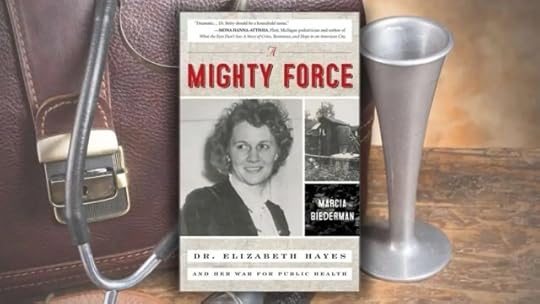 Credit: BookTrib.com
Credit: BookTrib.comDr. Elizabeth Hayes is not well-known, but she ought to be. According to Marcia Biederman, author of A Mighty Force: Dr. Elizabeth Hayes and Her War for Public Health (Prometheus), Dr. Hayes takes on a major corporate entity embroiled in corruption to make life better for her patients, the coal miners of Force, PA, a town owned by the Shawmut Mining Company. There was never a more apt title for this biography of a female powerhouse.
Biederman tells the compelling story of a woman who fought for better sanitation for the miners to prevent disease. It is difficult to conceive of Americans having to endure sewage in their yards, streets and rivers during the World War II era, seeping into their wells and contaminating their drinking water. Yet “Dr. Betty,” the Shawmut Mining Company’s physician, witnessed it firsthand through her visits to patients’ homes. Biederman describes each house as having “a sagging porch, a coal shed in the front yard, and an oozing outhouse in the back.” The unpaved roads cause Dr. Hayes to fall into a puddle of crud before arriving to deliver a baby. Those same muddy roads make it difficult for an ambulance to get through.
A suspected case of typhoid leads Hayes to pay for private testing of the wells. As she suspects, the water is contaminated. It is no wonder, since Shawmut neglects to maintain the outhouses. As a result, rainstorms cause feces to flow down streets and alleys. Such conditions force Hayes to resign her position, citing that “I see no point in maintaining Well Baby clinics if we are going to mix the babies’ formulas with toilet water.”
THIS JUST CAN’T GO ON
Her decision results in the 350 coal miners walking off the job, refusing to work without a doctor. Hayes pledges to remain and help the men fight for better conditions. Since the corporate overlords view their workers as “cartoonish, content with their lot, clothed but not quite human,” it would be an uphill battle. To further complicate matters, Shawmut Mining Company has been in receivership for forty years, using it as a scheme to enrich its executives. Such corruption would need to be exposed to achieve victory for the men.
Dr. Hayes becomes an instant celebrity and media darling with the press. An attractive woman dressed in “ruffled blouses, appliqued dresses, puckered sleeves, and veiled hats” fighting for public health made for a captivating story. The Philadelphia Record, a major daily newspaper, applauded Hayes’ mission and her motto: “Get good and mad — and start fighting.” Her battle for the miners achieves international recognition as papers across America and the world pick up on the story. While not inviting nor enjoying her fame, Hayes did use it to her advantage. Biederman writes, “The overnight sensation handled the media like a seasoned pro. Always quotable but often limiting herself to a few talking points, she kept her guard up with all but a few journalists.” Major publications such as the New York Times and Newsweek present her case in a sympathetic light; many writers, particularly gossip columnists, are particularly enthralled with “Dr. Betty.”
Marcia Biederman’s background as a newswoman and fiction writer serves her well in telling the story of Dr. Elizabeth Hayes. A Mighty Force exhibits a crisp, journalistic style that moves the story with a sense of urgency. I sometimes found it challenging to keep track of all the players. Still, the importance of Dr. Hayes’ contribution to the public health fight of deserving miners makes the extra work of reading attentively well worth the time.
A Mighty Force is an important story that brings to the forefront forgotten people: the downtrodden workers and the woman doctor who put aside her own needs and desires to fight for their cause. Dr. Hayes is a fine example of how to make the world a better place. A Mighty Force ensures that her story lives on.
Q&A WITH THE AUTHOR
Q: How did you come to know of Dr. Betty Hayes? Was it your interest in the time period, her medical background, the role of women during World War II, etc.?
A: Ironically, I was searching for a businesswoman to write about when instead I stumbled upon Dr. Hayes, who effectively became a labor leader despite having no official position in any union. My previous two biographies were about 20th-century female entrepreneurs, restaurateur Patricia Murphy and speed-reading marketer Evelyn Wood. Both those women had been featured in a magazine called the Investor’s Reader, published by Merrill Lynch from 1943 to 1973. Surprisingly, that pocket-sized digest ran financial news about women fairly regularly.
So I went to the New York Public Library to consult the magazine’s end-of-year indexes and skim them for women’s names. Any time I saw a name like Alice or Sally in the index, I’d request the issue and read the article. After a few false starts, I found Dr. Elizabeth Hayes and her struggle for sanitation under the heading, “The Doctor Prescribed.” Her actions ended a 40-year corporate scheme that enriched its executives while letting coal communities fester and creditors go unpaid. Investor’s Reader applauded her for it.
Q: How did your journalistic background help you to research this book? How did you know that so much had been written about her in the newspapers?
A: I immediately found scores of articles about her through the usual databases: newspapers.com, Proquest and so forth. Editorial writers nationwide were rooting for “Dr. Betty’s miners,” as one paper called them, and G.I.s overseas followed the strike in Stars and Stripes. Locating the stories was easy but I had to re-read them to find the arc of the story — how the central figures were changed by events.
Here my fiction writing background served me better than my experience in journalism. For example, at one point, I detected Hayes’s panic at becoming an overnight celebrity. Known for her kindness with patients, she turned testy with an interviewer who asked her a few innocent personal questions: whether she had a boyfriend and if she’d seen a particular movie. Soon after, Hayes fled town for a few days on an unannounced “vacation,” which was very unusual for her. I noticed another dip in Hayes’s morale when her mother moved from the house they’d shared. It must have been hell for Hayes to lead a struggle and work endless hours as a doctor with all her relatives living elsewhere.
Q: Did you realize when you started researching Betty Hayes that there were no personal papers that had survived? How did you manage without such important material? I imagine it must have been difficult not being able to read her own words on the matter.
A: I would have loved to have had her papers, of course, but this is an occupational hazard for all biographers of forgotten or unsung women. I had many quotations from her from reputable reporters with whom she’d forged relationships, and I spent many hours connecting dots and reading between lines. Thanks to the Indiana University of Pennsylvania collections, I also have an account of the demands she made to the mining company at a meeting where she thoroughly shocked the executives present. I’m also grateful to the Cornell University Library for the scrapbook and correspondence of a local grocer who followed every twist and turn of the strike and its aftermath. I also have an affidavit she signed after company officials raided her medical office. All of this gave me a clear picture of her and added to the story. Even if I had found her letters, they probably would have offered only one side of the correspondence.
Q: What was your reaction to the conditions that the miners had to live in? I was surprised that, in the 1940s, conditions were so poor. Was this part of the draw of writing this book?
A: I was, indeed, shocked to learn that the Pennsylvania Department of Health tolerated this level of filth in 1945. In the first decade of the century, there had been a terrible typhoid epidemic in Butler, PA, traced to fecal contamination of the water supply — the very same problem that existed in Force. After trying unsuccessfully to conceal the infections and deaths, Butler ended up begging the nation for help. Money and medical staff poured in, and Clara Barton took charge.
Yet less than 40 years later, state authorities said there was little they could do for Force because company-owned towns were private property. If Hayes hadn’t sounded alarms and persuaded a federal judge to order a clean-up, who knows what would have happened? By 1945, antibiotics were available, but prevention is better than treatment, as we’re re-learning now. I finished my research and began writing at the start of the pandemic and the new focus on public health, which gave me fresh reasons to tell Hayes’s story.
December 11, 2021
“A MIGHTY FORCE” NAMED A BEST BOOK OF 2021
Hooray! A Mighty Force won a coveted place on the 2021 MIGHTY WOMEN READING LIST FOR ADULTS created by the website A Mighty Girl. (How many times can you count the word “mighty” in this post?)
AMightyGirl.com is a great resource for inspiring books, games, and toys for girls, women, and their allies. It also has tips on what to say to young female relatives this holiday season besides, “Aren’t you cute?” It’s an honor to be on its best-of list!

 IT’S AN HONOR TO HAVE A MIGHTY FORCE IN THIS GOOD COMPANY ON THE “BEST OF” LIST
IT’S AN HONOR TO HAVE A MIGHTY FORCE IN THIS GOOD COMPANY ON THE “BEST OF” LIST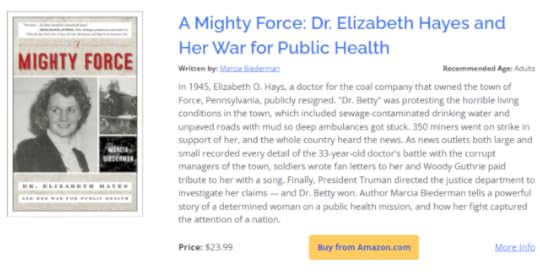
November 18, 2021
Dr. Betty Hayes lives on in Byrnedale, PA!
The best thing about writing books is hearing from readers. Recently, I was thrilled to get this message:
Hello. I know you don’t know me but I just finished reading your book, A Mighty Force, about Dr. Betty Hayes. I live in Byrnedale in my grandparents’ house. I was raised here too. My house was originally number 123. My family has lived here since 1924. My mother was born here in 1930. So many things you wrote about, my mother talked about. I believe my friends and neighbors should realize what Appalachian poverty really was. I’m not sure if you have ever visited but if do, you’ll be welcome to see the past and the present. Many descendants of the miners are still here or they left and came home. I did. Thank you for sharing this story. Denise M. Cuneo, Esq.
Denise and I were able to connect for a long telephone chat. I learned that in 1945, her grandfather was working for Shawmut Mining. He was one of the heroic miners that I described in my book. These gutsy heroes staged a five-month strike to support Dr. Elizabeth Hayes’s demands for sanitation, sewage removal and tolerable living conditions in their company-owned towns. They skipped many weeks of paychecks and endured company harassment with the full support of their wives and grown children.
Denise’s grandparents, John and Mary DeCarli, are the reason why Byrnedale, Force and Hollywood are still on the Pennsylvania map. Mining concerns had no interest in the future of these company towns, which they built hastily, let deteriorate, and abandoned when there was no more coal. Thanks to “Dr. Betty” and the mining families who supported her, the miners of these three valley hamlets won the deeds to their homes and the right to improve them. Now Denise is the third generation of her family to live in Byrnedale, while other coal towns have disappeared.
The valley’s only lawyer, Denise has somehow found time to improve her childhood home further with a new roof, new windows, and new siding. A kitchen renovation is also underway. Long gone are the outdoor privies that used to stand in Byrnedale backyards. Even after the miners won all their demands, including the right to buy their homes, it took several years to install indoor toilets.
The outhouses were unsightly and inconvenient. Worse, they were a health threat. Describing the three striking coal communities, the Pittsburgh Post-Gazette wrote in August 1945, All three towns, particularly Force and Byrnedale, wallow in sewage that overflows from the open privies with every hard rain. The sewage runs through the gutters along the almost impassable streets, between the houses, into the gardens, into the cellars—and in Force, into the wells that supply the town’s drinking water.”
Byrnedale, unlike Force, could draw water from a clean reservoir. But, though it wasn’t always easy, the three valley towns stood together, eventually gaining support from President Harry S. Truman’s Department of Justice, and winning the strike.
Denise has generously given me permission to share family photos taken in those times. I look forward to meeting her in March 2022 when I plan to re-visit Force and see Byrnedale for the first time.
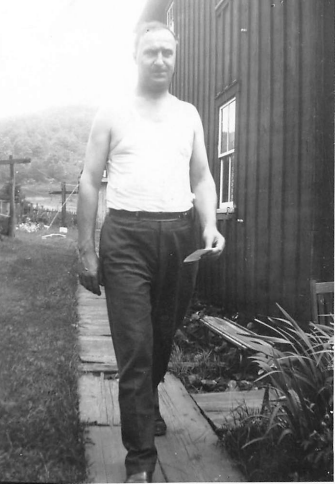 Denise Cuneo’s grandfather, John DeCarli, on a wooden sidewalk in Byrnedale in 1945. He was one of the 350 coal miners who struck for sanitation and the right to own their own homes.
Denise Cuneo’s grandfather, John DeCarli, on a wooden sidewalk in Byrnedale in 1945. He was one of the 350 coal miners who struck for sanitation and the right to own their own homes.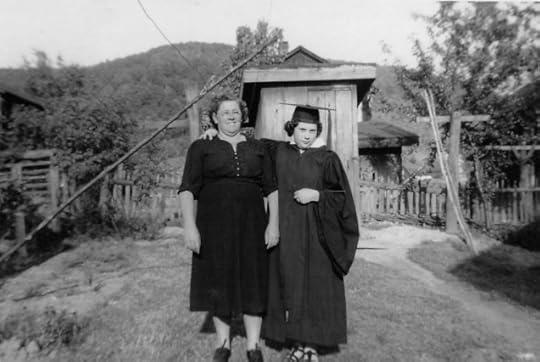 Denise’s mother, Dolores “Lulie” DeCarli, and her mother Mary pose before the outhouse in their yard. It’s high school graduation day.
Denise’s mother, Dolores “Lulie” DeCarli, and her mother Mary pose before the outhouse in their yard. It’s high school graduation day. Picture Day at the Byrnedale School in 1938. Luli’s mother is in the front row, third from left. Her best friend, Linnie Gilbert, second row, first on left, was a daughter of Byrnedale’s only Black miner. Five years after this photo was taken, most of these children became patients of Dr. Betty Hayes. With many male doctors enlisted in the Armed Forces, Hayes was the valley’s only physician, responsible for 4,000 lives.
Picture Day at the Byrnedale School in 1938. Luli’s mother is in the front row, third from left. Her best friend, Linnie Gilbert, second row, first on left, was a daughter of Byrnedale’s only Black miner. Five years after this photo was taken, most of these children became patients of Dr. Betty Hayes. With many male doctors enlisted in the Armed Forces, Hayes was the valley’s only physician, responsible for 4,000 lives.
October 29, 2021
My NY Daily News op-ed: lessons for today from A MIGHTY FORCE
I’m immensely pleased that the New York Daily News chose to run my op-ed today. It compares the widespread public support in 1945 for the coal strike led by Dr. Elizabeth Hayes with the apathy surrounding a hunger strike, now in its second week, by New York taxi drivers.
The cabbies desperately need the City of New York to grant them relief. Before Uber and Lyft, they were encouraged by the city to buy taxi medallions — permits to own and operate cabs. TV ads and city-run auctions urged them to sink their life savings, sometimes hundreds of thousands of dollars, into the medallions. Because the city long regulated the number of legal cabs on the street, this seemed like a sure-fire investment. Immigrants who’d barely mastered English were assured that, with hard work and long hours, a medallion was a ticket to the middle class.
With the advent of ride-sharing apps, this has all come crashing down. At least nine New York cabbies have died by suicide, unable to face staggering debts for which the City so far has offered inadequate relief. Now they’re on a group hunger strike, protesting —sometimes around the clock —in front of City Hall. Yet most passers-by and the media pay them little mind.
Contrast that with the America described in my book A MIGHTY FORCE, where people’s hearts went out to Dr. Hayes and the striking miners. Worrying about others, overseas and on the home front, was common during World War 2. As I write, that’s why the coal industry had to form a public-relations branch. People wanted to know why miners lived such a hard life, and the coal operators needed to prepare glib answers.
My op-ed appears below.
 From the NY Daily News, October 29, 2021
From the NY Daily News, October 29, 2021
October 14, 2021
How I “met” Dr. Elizabeth Hayes, hero of A MIGHTY FORCE
“How did you develop an interest in a woman from the Pennsylvania hinterlands?” That question came from Barb Emmer, who lives in those “hinterlands” herself. Like me, Barb is a Dr. Betty fan who’s done a huge amount of her own research into Hayes’s role in leading 350 coal miners on a 1945 strike for decent living conditions and clean drinking water in their company-owned town. She’s also given me the great honor of an invitation to talk about A MIGHTY FORCE at a luncheon scheduled for March 19, 2022, during Women’s History Month.
I’m tremendously excited about speaking on Dr. Betty’s home turf, and I expect that others will ask me that same question there: How did a writer from Brooklyn get interested in someone from the north-central Pennsylvania hills?
Ironically, I have to thank Wall Street for introducing me to Dr. Elizabeth Hayes of Force, PA. The strike, sparked by her resignation as company doctor for Shawmut Mining, shed light on the questionable financial practices of the railroad that owned the mining concern. In the end, Hayes’s actions forced the Pittsburg, Shawmut & Northern Railroad to go out of business. She was the woman who ended the nation’s longest receivership — PS&N heads had drawn handsome salaries for decades while leaving the rail line bankrupt — and the business press saluted her for it.
I discovered this by searching for women’s names in the year-end indexes of a pocket-sized magazine called the Investor’s Reader. From 1943 to 1973, this biweekly publication ran breezy stories about business and finance. Merrill Lynch put it out, hoping to draw average people into the stock market. Most articles, predictably, revolved around males. But, as I noticed while writing my previous books, it wasn’t unusual for Investor’s Reader to write features about women. A fair number of women wrote for the magazine over its lifetime, perhaps because it launched in the war years.
So, having drawn on Investor’s Reader for my two previous books about women in business — POPOVERS AND CANDLELIGHT, about restaurateur Patricia Murphy, and SCAN ARTIST — about speed-reading marketer Evelyn Wood — I went to the New York Public Library to consult the year-end lists of Investor’s Reader articles. I began with the 1940s because I’m interested in that decade, and I skimmed each December list of the decade for women’s first names.
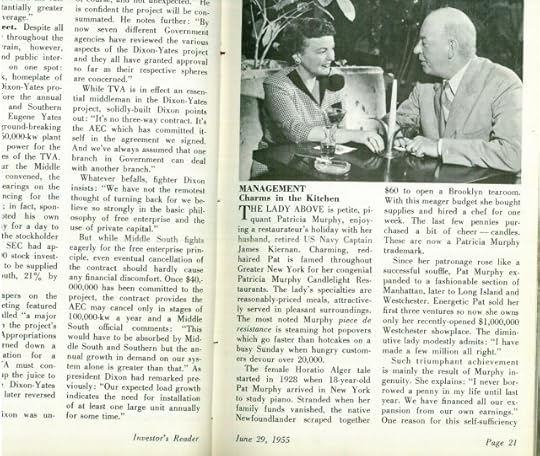 An Investor’s Reader feature about Patricia Murphy, which I drew on for my previous book
An Investor’s Reader feature about Patricia Murphy, which I drew on for my previous bookThis took me to articles about one woman with a successful textile mill and another who ran a profitable brewery with her husband. Neither seemed to be likely subjects for a book. As in fairy tales, the third try was the charm. My authorial antennas quivered madly as I read a short summary about Dr. Betty Hayes and her battle with the coal company, which, the article told me, “made front-rank news in almost every daily paper in the East as well as in periodicals like Business Week.”
From there, I found the articles, as well as the photos at the Historical Society of Pennsylvania, the letters and papers in the collections of Indiana University of Pennsylvania, Cornell, and Penn State, and the memories of Hayes’s niece and stepson. To all who have helped me, I’m profoundly grateful. And to Merrill Lynch (then Merrill Lynch, Pierce, Fenner & Beane) a special tip of the hat (with veil — remember, this is the Forties)!
[image error]My first introduction to Dr. Elizabeth Hayes: the section headed, “The Doctor Prescribed.” No photo, unfortunately.
July 9, 2021
New Wikipedia entry on Dr. Elizabeth “Betty” Hayes
Traffic is already building on the new Wikipedia page about Dr. Elizabeth “Betty” Hayes, the subject of my forthcoming book, A Mighty Force, to be released in October 2021. As a Wikipedia editor, I got the ball rolling, but there are many other “Dr. Betty” fans out there who are already contributing to the article. Like everything else on Wikipedia, the article is a living document and a collaborative effort.
One editor already objected to the description of Hayes as “slim, blond, and quotable,” explaining that they found this sexist. (The phrase had appeared in the sentence, “Slim, blonde and quotable, Hayes became an overnight sensation” in the press.) What do you think? Send me a comment on this page, or click the “contact” tab to leave me your thoughts.
June 2, 2021
Scan Artist Mentioned in a Top 10 Podcast!
It was beyond thrilling to hear the hosts of the Stuff You Should Know podcast debunk Evelyn Wood’s speed-reading system in their May 17, 2021, Shortstuff installment. My book Scan Artist is mentioned at 07:40, about seven minutes into the 14-minute segment. You can listen here. Much of what’s discussed is in my book.
I’m particularly delighted that Josh Clark and Chuck Bryant, the creators of this tremendously popular podcast, saw the parallels between Evelyn Wood Reading Dynamics and Scientology. In both cases, the companies pulled out all the stops to silence their critics. They also counted on “pride and shame,” as Clark and Bryant put it, to keep disappointed consumers from requesting refunds or voicing their dissatisfaction. After spending a lot of money on an Evelyn Wood course, people didn’t like to admit they’d thrown their money away. Instead, most blamed themselves for their failure to speed-read. Scientology works the same way, as the podcast points out.
I can now admit that between the late 1960s and early Seventies, not only did I waste my parents’ money on an Evelyn Wood course, but I also bought one ridiculous tutoring session with a Scientologist. I cannot speed-read nor am I “clear.” However, I am overjoyed to be featured on one of the world’s most popular podcasts!
Scan Artist Mentioned by a Top 10 Podcast!
It was beyond thrilling to hear the hosts of the Stuff You Should Know podcast debunk Evelyn Wood’s speed-reading system in their May 17, 2021, Shortstuff installment. My book Scan Artist is mentioned at 07:40, about seven minutes into the 14-minute segment. You can listen here. Much of what’s discussed is in my book.
I’m particularly delighted that Josh Clark and Chuck Bryant, the creators of this tremendously popular podcast, saw the parallels between Evelyn Wood Reading Dynamics and Scientology. In both cases, the companies pulled out all the stops to silence their critics. They also counted on “pride and shame,” as Clark and Bryant put it, to keep disappointed consumers from requesting refunds or voicing their dissatisfaction. After spending a lot of money on an Evelyn Wood course, people didn’t like to admit they’d thrown their money away. Instead, most blamed themselves for their failure to speed-read. Scientology works the same way, as the podcast points out.
I can now admit that between the late 1960s and early Seventies, not only did I waste my parents’ money on an Evelyn Wood course, but I also bought one ridiculous tutoring session with a Scientologist. I cannot speed-read nor am I “clear.” However, I am overjoyed to be featured on one of the world’s most popular podcasts!



